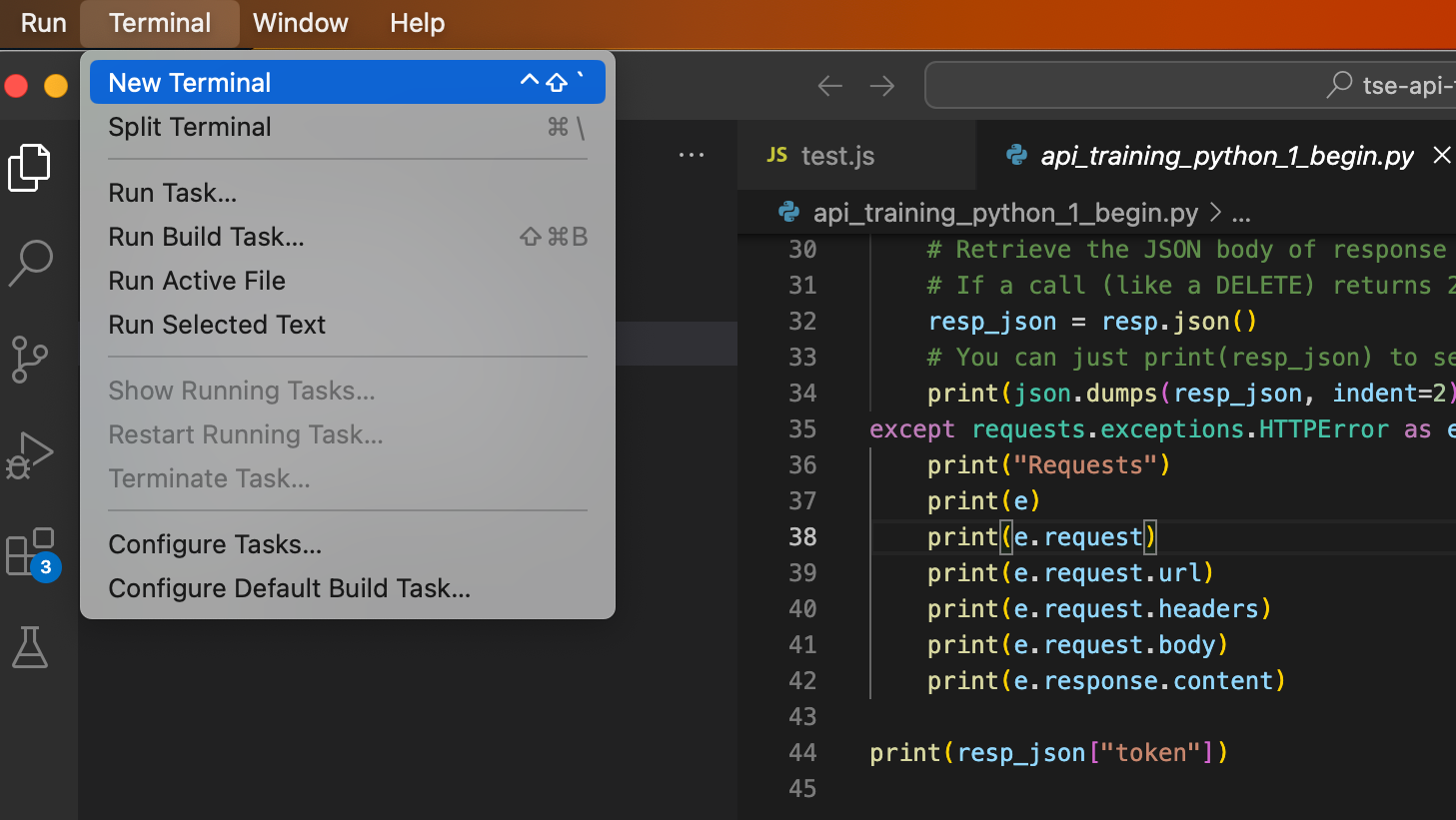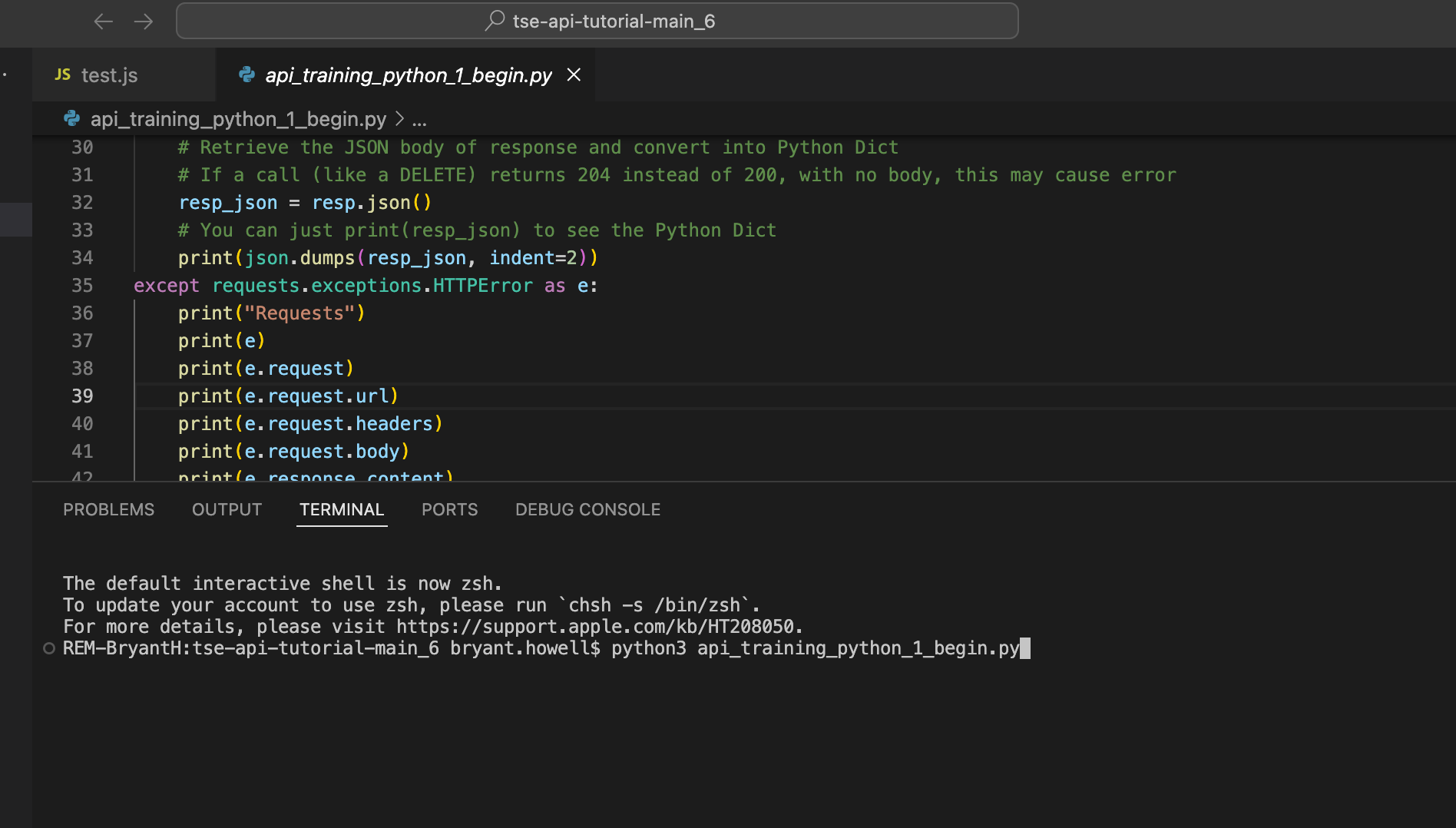import requests
import jsonSimple Python implementation of V2.0 REST API
Get started🔗
We’ll use the files from the tse-api-tutorial GitHub repository that you downloaded at the beginning of the tutorial.
-
Open your IDE
Visual Studio Code will be used in all images and instructions. The files for this lesson areapi_training_python_1_begin.pyandapi_training_python_1_end.py -
Open up your command line or terminal environment as well.
|
Note
|
There are many ways to install and configure Python on a system. This tutorial shows "plain" versions of all commands as if you are using the main system-wide install of Python for the tutorial. Please adjust all Python commands according to your own environment. |
01 - Imports and variables🔗
At the top of api_training_python_1_begin.py, there is a set of imports and variables that configure the overall script.
Import Requests library🔗
To issue HTTP commands in a given programming language, you must use a library that sends and receives HTTP.
For this lesson, we’ll use Requests, the most commonly used high-level HTTP library for Python.
The file starts with import commands for the json standard Python package and the requests package, which must be installed.
Install requests package🔗
If you followed the prerequisites and installed the thoughtspot_rest_api_v1 package using your command line or terminal:
pip install thoughtspot_rest_api_v1
The requests package should have automatically been installed along with the other requirements.
You can double-check the installation or force a version upgrade using the following command:
pip install requests --upgrade
Set global variables🔗
It is very convenient to declare global variables at the beginning of a script so that they can be reused throughout.
The URL of the ThoughtSpot instance is always necessary to send a REST API command, and if the instance has Orgs enabled, you need to send the org_id when you request a login token. We’ll set those as global variables along with the api_version (which hasn’t changed ever at this point).
import requests
import json
thoughtspot_url = 'https://{}.thoughtspot.cloud'
org_id = 1613534286
api_version = '2.0'Now, let’s construct the starting portion of any API endpoint URL and define the most basic headers that will be used by every call:
...
base_url = '{thoughtspot_url}/api/rest/{version}/'.format(thoughtspot_url=thoughtspot_url, version=api_version)
api_headers = {
'X-Requested-By': 'ThoughtSpot',
'Accept': 'application/json'
}02 - Use a Session object🔗
Rather than set the full configuration of each HTTP request you make, you can construct a Session object from the requests library, which an open HTTP connection and maintains settings like headers and cookies between individual HTTP actions.
You send HTTP commands by calling the .get(), .post(), .put() and .delete() methods of the Session object.
All of those methods will return a Response object, which you assign to a variable to do further processing. This will look something the following:
# Create a new Session object
requests_session = requests.Session()
# Set the headers for all uses of the requests_session object
requests_session.headers.update(api_headers)
# Define the JSON message, in Python object syntax (close but not exactly JSON)
json_post_data = { // a request body }
# Set the URL of the endpoint
url = base_url + "{api_endpoint_ending}"
# Issue the HTTP request and store the response to a variable
resp = requests_session.post(url=url, json=json_post_data)03 - Authenticate into ThoughtSpot REST API🔗
There are two ways of establishing authentication with ThoughtSpot’s REST API, cookie-based with session cookies and cookieless using a bearer token in the headers.
For backend scripts, we prefer the bearer token approach:
-
Request a Full Access Token
-
Update the Session object headers with the token
-
Make any additional REST API requests
Request a full access token🔗
In the REST API V2.0 Playground:
-
Go to Authentication > Get Full Access Token.
-
Specify the parameters.
-
Copy the JSON body from the right side of the Playground, Python Dict uses the same syntax, but you must update the booleans to be uppercase.
-
Replace any of the hard-coded values with the global variables you declared so that you can change your requests in an easy way at the top of your script and make sure the values change in all the necessary places:
... endpoint = 'auth/token/full' url = base_url + endpoint json_post_data = { "username": "yourusername", "password": "y0urP@ssword", "validity_time_in_sec": 3600, "org_id": org_id, "auto_create": False # make sure to uppercase in Python } -
Make a
.post()request using theSessionobject.We expect a JSON response on success, which you can access using the
.json()method of theResponseobject.From the Playground, we can see that there is
tokenproperty in the response. -
Create a variable for the
tokenvalue to use in the headers as the Bearer token..... resp = requests_session.post(url=url, json=json_post_data) resp_json = resp.json() print(json.dumps(resp_json, indent=2)) token = resp_json["token"] print("Here's the token:") print(token) ....
Run the script to test🔗
At this point, the code should be functional. You can test in your IDE (Visual Studio Code pictured) by opening a Terminal, then running the script via the appropriate python command:


If you have a more complex local Python environment you are using, find the appropriate way to send the script you have updated through the Python environment set up for this tutorial.
Update the Session object headers🔗
Almost all REST API endpoints other than the token requests require authentication, either within the cookies or via an Authentication: Bearer {token} header.
You need to update the Session object with this new header while keeping the original ones.
Use the token variable from above to form the exact header to update the original api_headers Dict, then use the .headers.update() method of the Session object:
...
token = resp_json["token"]
# Update api_headers from before with header for Bearer token
api_headers['Authorization'] = 'Bearer {}'.format(token)
requests_session.headers.update(api_headers)04 - Handle errors from the REST API🔗
The code we have written so far is correct from a logical perspective, but only works properly if everything goes as expected.
Unfortunately, making a REST API request to a web server can result in any number of errors, even if the communication back and forth completes successfully.
Good coding involves testing for and handling error situations.
Using try and except in Python🔗
Python code raises Exceptions when an error is encountered.
If an Exception is raised and is not handled, the script exits and displays the message provided with the Exception and other details of what failed.
A try…except block encloses a set of lines that may result in a known Exception in the try portion, and then the except line defines which Exception type to listen for and how to proceed if the Exception is thrown.
Every HTTP request can potentially result in an error, and we don’t want to continue within the script as planned if the expected action on the ThoughtSpot server did not complete correctly.
The most generic try…except block will capture any Exception:
try:
resp = requests_session.post(url=url, json=json_post_data)
resp_json = resp.json() # Returns JSON body of resp to Python Dict
print(resp_json)
token = resp_json["token"]
except Exception as e:
# do whatever is necessary in exception case
# Code after the try block will now run even after ExceptionChecking for requests HTTPError exceptions🔗
The requests library does not raise an Exception when an HTTP request completes "properly", that is to say a well-formed HTTP response is received from a request.
However, as you saw in the previous lesson, HTTP responses include a Status Code that indicates if the requested action was a Success or an Error.
To cause Exceptions if the response does not include a Success status code, call the Response.raise_for_status() method for each call, which will throw the specifc requests.exceptions.HTTPError Exception when a 400 series or 500 status code is returned:
try:
resp = requests_session.post(url=url, json=json_post_data)
resp.raise_for_status()
print(resp)
token = resp["token"]
except requests.exceptions.HTTPError as e:
print(e)
print(e.request)
print(e.request.url)
print(e.request.headers)
print(e.request.body)
print(e.response.content)05 - Complete REST API request example🔗
With the addition of try…except blocks looking for HTTPError when we make the HTTP request, we now have a complete basic pattern for using the ThoughtSpot V2.0 REST API:
import requests
import json
thoughtspot_url = 'https://{}.thoughtspot.cloud'
org_id = 0
api_version = '2.0'
endpoint = 'auth/token/full'
url = base_url + endpoint
json_post_data = {
"username": "yourusername",
"password": "y0urP@ssword",
"validity_time_in_sec": 3600,
"org_id": org_id,
"auto_create": False # make sure to uppercase in Python
}
try:
# requests returns back Response object
resp = requests_session.post(url=url, json=json_post_data)
# This method causes Python Exception to throw if status not 2XX
resp.raise_for_status()
# Retrieve the JSON body of response and convert into Dict
# Some endpoints returns 204 not 200 for success, with no body, will error if you call .json() method
resp_json = resp.json()
# You can just print(resp_json) to see the Python Dict
print(json.dumps(resp_json, indent=2))
# 'token' property of the response is the Bearer Token to use
token = resp_json["token"]
except requests.exceptions.HTTPError as e:
print(e)
print(e.request)
print(e.request.url)
print(e.request.headers)
print(e.request.body)
print(e.response.content)
# Update api_headers from before with header for Bearer token
api_headers['Authorization'] = 'Bearer {}'.format(token)
requests_session.headers.update(api_headers)
# Issue any other command using the same requests_session object
user_search_url = base_url + "users/search"
# Every request must be wrapped in try...except
try:
search_resp = requests_session.get(url=user_search_url)
search_resp.raise_for_status()
...You may have noticed many steps that are repeated each time for any given request.
In the next lesson, we’ll cover using a library that wraps most of these repeated steps, so that you can focus simply on the logic of your API workflows.